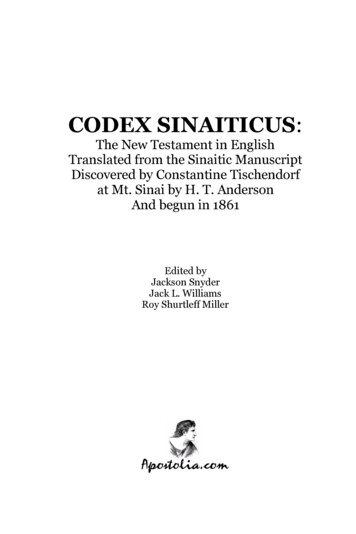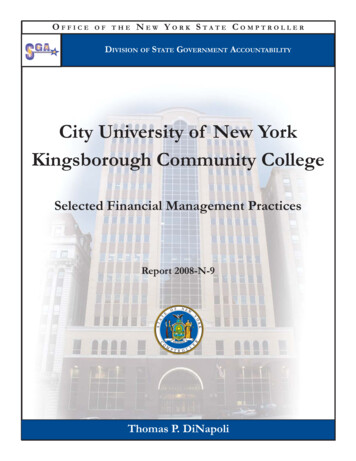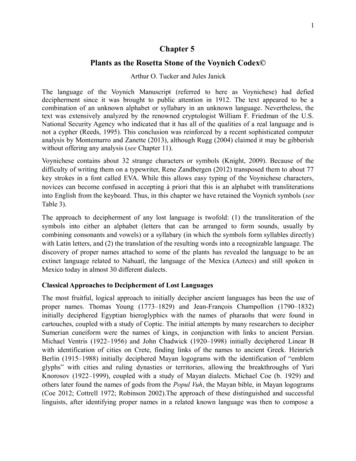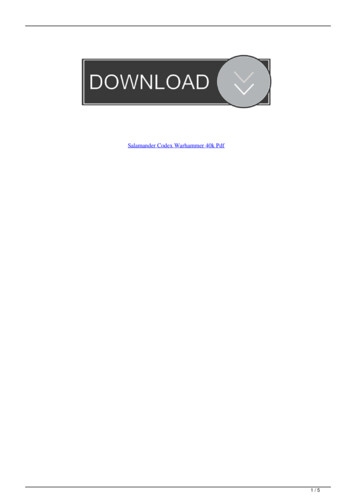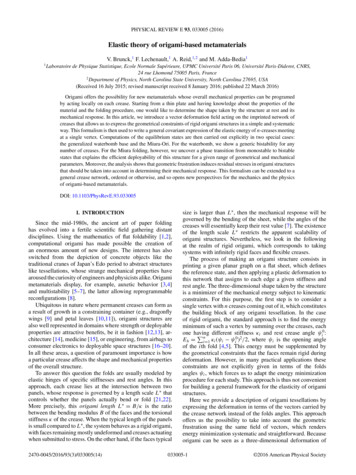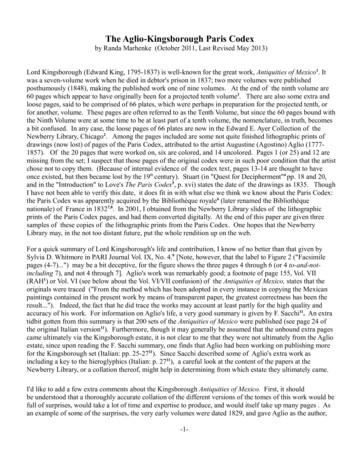
Transcription
The Aglio-Kingsborough Paris Codexby Randa Marhenke (October 2011, Last Revised May 2013)Lord Kingsborough (Edward King, 1795-1837) is well-known for the great work, Antiquities of Mexico1. Itwas a seven-volume work when he died in debtor's prison in 1837; two more volumes were publishedposthumously (1848), making the published work one of nine volumes. At the end of the ninth volume are60 pages which appear to have originally been for a projected tenth volume3. There are also some extra andloose pages, said to be comprised of 66 plates, which were perhaps in preparation for the projected tenth, orfor another, volume. These pages are often referred to as the Tenth Volume, but since the 60 pages bound withthe Ninth Volume were at some time to be at least part of a tenth volume, the nomenclature, in truth, becomesa bit confused. In any case, the loose pages of 66 plates are now in the Edward E. Ayer Collection of theNewberry Library, Chicago2. Among the pages included are some not quite finished lithographic prints ofdrawings (now lost) of pages of the Paris Codex, attributed to the artist Augustine (Agostino) Aglio (17771857). Of the 20 pages that were worked on, six are colored, and 14 uncolored. Pages 1 (or 25) and 12 aremissing from the set; I suspect that those pages of the original codex were in such poor condition that the artistchose not to copy them. (Because of internal evidence of the codex text, pages 13-14 are thought to haveonce existed, but then became lost by the 19th century). Stuart (in "Quest for Decipherment"4 pp. 18 and 20,and in the "Introduction" to Love's The Paris Codex5, p. xvi) states the date of the drawings as 1835. ThoughI have not been able to verify this date, it does fit in with what else we think we know about the Paris Codex:the Paris Codex was apparently acquired by the Bibliothèque royale6 (later renamed the Bibliothèquenationale) of France in 18327,8. In 2001, I obtained from the Newberry Library slides of the lithographicprints of the Paris Codex pages, and had them converted digitally. At the end of this paper are given threesamples of these copies of the lithographic prints from the Paris Codex. One hopes that the NewberryLibrary may, in the not too distant future, put the whole rendition up on the web.For a quick summary of Lord Kingsborough's life and contribution, I know of no better than that given bySylvia D. Whitmore in PARI Journal Vol. IX, No. 4.9 [Note, however, that the label to Figure 2 ("Facsimilepages (4-7).") may be a bit deceptive, for the figure shows the three pages 4 through 6 (or 4 to-and-notincluding 7), and not 4 through 7]. Aglio's work was remarkably good; a footnote of page 155, Vol. VII(RAH1) or Vol. VI (see below about the Vol. VI/VII confusion) of the Antiquities of Mexico, states that theoriginals were traced ("From the method which has been adopted in every instance in copying the Mexicanpaintings contained in the present work by means of transparent paper, the greatest correctness has been theresult."). Indeed, the fact that he did trace the works may account at least partly for the high quality andaccuracy of his work. For information on Aglio's life, a very good summary is given by F. Sacchi11. An extratidbit gotten from this summary is that 200 sets of the Antiquities of Mexico were published (see page 24 ofthe original Italian version11). Furthermore, though it may generally be assumed that the unbound extra pagescame ultimately via the Kingsborough estate, it is not clear to me that they were not ultimately from the Aglioestate, since upon reading the F. Sacchi summary, one finds that Aglio had been working on publishing morefor the Kingsborough set (Italian: pp. 25-2711). Since Sacchi described some of Aglio's extra work asincluding a key to the hieroglyphics (Italian: p. 2711), a careful look at the content of the papers at theNewberry Library, or a collation thereof, might help in determining from which estate they ultimately came.I'd like to add a few extra comments about the Kingsborough Antiquities of Mexico. First, it shouldbe understood that a thoroughly accurate collation of the different versions of the tomes of this work would befull of surprises, would take a lot of time and expertise to produce, and would itself take up many pages . Asan example of some of the surprises, the very early volumes were dated 1829, and gave Aglio as the author,-1-
without mention of Kingsborough. Though Kingsborough appears to have intended to finance the work,sincethe beginning volumes were of Aglio's work, it seems justifiable that Aglio be credited for the work--at leastfor those beginning volumes. Lord Kingsborough may well have been annoyed at Aglio being solely creditedfor the work however, for the later sets give Kingsborough as the author, with Aglio as the person who did "thedrawings, on stone". Whoever deserved the credit for the monumental work, the tragedy of the circumstanceswas that both died destitute from their efforts.Two main types of Antiquities of Mexico were published: one with color plates, the other with uncolored linedrawings. Apparently lithographic prints of the line drawings were taken and colored individually by Aglio,or under his direction, to make the colored plates. The colored varieties always fetched a higher price. Besidessome references stating implicitely that these two varieties existed, some stated the fact explicitely. An articlein the Foreign Quarterly Review of 183210 states in the footnote on p. 91, "The price is 120 with the platesin plain outline, and 175 coloured." By 1869, Sabin12 expected to get 450 for the colored variety, and 140for the one with "plain plates". Boban in 1899 (p.7113) said that the plain variety got 1,000 to 1,200 francs,and the colored variety got 2,000 to 2,500 or more francs. The Library of Congress, in addition to its colorededitions, has an uncolored edition listed as "Copy 2" in its Online Catalog14. Of further interest here is thatGates, in the booklet that came with his rendition of the Dresden Codex15, stated in the third from the lastparagraph that he traced the figures from enlargements "made from an uncolored copy of the Kingsborough".But anyone now hoping to get a copy of one of the usually "less desirable" uncolored sets of a Kingsboroughcheaply better forget it. In 2007, the price realized was 21,15016 for an uncolored set. Yes, that is a lot lessexpensive than the colored one currently expected to bring 50,000- 70,00017. But it doesn't really matter;both are too expensive for most of us.Then there are the different arrangements of the volumes. At least one set (the one described by GeorgeStuart18) was published with an Aglio reproduction of a Vatican 96-page codex (i.e., Vaticanus B, also knownas Vaticanus 3773) in Vol. II, but numerous other sets have it in Vol. III. Furthermore, the contents of VolumesVI and VII of the RAH set appear to be interchanged when compared with the contents in Volumes VI and VIIof other sets. Thus the digitization of the volume labelled as VI in the set held by the RAH has the contents ofwhat the other sets have in Volume VII, and Volume VII has what is in the other sets in Volume VI. Perhapsjust the title pages and spines of the volumes have been interchanged, but it still makes for a bit ofinconsistency. It is possible that the RAH mixed up the digitized pages, but I think that is unlikely. I havewritten asking them about this to make sure (in June 2011), but have received no reply. But I also notice that,as of this writing (October 2011), they have not changed their arrangement of the contents on their website,which may indicate that no change was necessary.As to the Paris Codex copy itself, each page has its printing on vellum21. There are two pages of the ParisCodex on the recto side of the vellum page only. These vellum pages are 49.3 cm high x 36.8 cm wide20 ,which is smaller than the page dimensions in the Kingsborough volumes as given by Schmitt (55.9 cm x 37.5cm)19, Boban (56 cm x 40 cm)13, and in the set described by Stuart (65.6 cm x 48.3 cm)18. On each of thesevellum pages there is a double-box image, measuring 24.6 cm x 24.8 cm, of copies of two pages of the ParisCodex. Each box of the double-box, and thus each copy of each Paris Codex page, is 12.3 cm x 24.8 cm.There is no signature mark on the vellum pages. The artwork of the copies is of lithographic prints of blacklines, followed by hand-painting of colors on some of the prints20. They may have been made as proofs,possibly for a later volume, i.e., one after 1848.The three sample pages from this copy of the Paris Codex attributed to Aglio, found with papers that are withKingsborough's Antiquities of Mexico housed in the Newberry Library, follow after the Acknowledgements.-2-
Notes, with References:1. Kingsborough1831-1848[RAH]2. Kingsborough1830-1848Antiquities of Mexico : comprising fac-similes of Ancient Mexican Paintings andHieroglyphics, preserved in the Royal Libraries of Paris, Berlin and Dresden; inthe Imperial Library of Vienna; in the Vatican Library; in the Borgian Museumat Rome; in the Library of the Institute al Bologna; and in the Bodleian Libraryat Oxford. Together with the Monuments of New Spain, by M. Dupaix: withtheir respective scales of measurement and accompanying Descriptions. Thewhole illustrated with many valuable Inedited Manuscripts, by LordKingsborough. The drawings, on stone, by A. Aglio.London : Volumes I-V: Robert Havell and Colnaghi, Son, and Co. : James Moyes : 1831Volumes VI-VII: Robert Havell and Colnaghi, Son, and Co.1831 : Richard Taylor 1830Volumes VIII-IX: H. G. Bohn : Richard and John E. Taylor : 1848[Note: Havell, Colnaghi, and Bohn were publishers; Moyes, and the Taylors wereprinters].Volumes I-VII are available from the Real Academia de Historia of Spain sulta/registro.cmd?id 5968Antiquities of Mexico : comprising fac-similes of Ancient Mexican Paintings andHieroglyphics, preserved in the Royal Libraries of Paris, Berlin and Dresden; inthe Imperial Library of Vienna; in the Vatican Library; in the Borgian Museumat Rome; in the Library of the Institute al Bologna; and in the Bodleian Libraryat Oxford. Together with the Monuments of New Spain, by M. Dupaix: withtheir respective scales of measurement and accompanying Descriptions. Thewhole illustrated with many valuable Inedited Manuscripts, by Augustine Aglio.LondonVolumes 1-9 , and "[Vol. 10]: A collection of 66 plates which were intended to formpart of an unpublished tenth volume. Some plates hand colored".The Newberry Library Catalog entry is Pwebrecon.cgi?DB local&v1 1&BBRecID 4855283. Allibone,S. Austin1872A Critical Dictionary of English Literature and British and American Authors, Vol. I,J.B. Lippincott & Co., Philadelphia, p.1033, col. B. [Though the date of publication isgiven as 1872, the publication was "entered, according to an act of Congress.in theclerk's office of the District Court of the United States." in 1854, 1858. 1858 is alsothe date of dedication].Accessible at:http://books.google.com/books?id 2p8MAAAAYAAJ4. Stuart,George E.1992"Quest for Decipherment: A Historical and Biographical Survey of MayaHieroglyphic Investigation" in Danien, Elin C., and Robert J Sharer, Editors: NewTheories on the Ancient Maya, University Museum Monograph 77, The UniversityMuseum, Philadelphia.5. Stuart,"Introduction", in Love, Bruce: The Paris Codex, Handbook for a Maya Priest,-3-
George E.1994the University of Texas Press, Austin.6. Larned, J. N., Article that includes information on the history of the Bibliothèque nationale de France:editor,"Libraries: France: The Bibliothèque Nationale", in History for Ready Reference,1895from the Best Historians, Biographers, and Specialists, vol. 3 (pp. 2010-2012), The C. A.Nichols Co., Springfield, Mass.Vol. 3 is accessible at: http://books.google.com/books?id bIghAQAAMAAJ7. Glass, John B. "247. Paris, Codex", in "A Census of Native Middle Americanwith DonaldPictorial Manuscripts", in Handbook of Middle American Indians,Robertsonvol. 14, eds. R. Wauchope (general editor), H. F. Cline (volume editor),1975University of Texas Press, Austin, pp. 179-180.8. Zimmermann, "Notas para la historia de los manuscritos mayas:, in: Yan:Günterciencias antropológicas, Mexico, D. F., vol.3, pp. 62-64.1954[This is of interest for early Peresianus and Cortesianus histories].9. Whitmore,Sylvia D.Spring 2009"Lord Kingsborough and his Contribution to Ancient Mesoamerican Scholarship:The Antiquities of Mexico", in The PARI Journal, San Francisco, Vol. IX, No. 4, pp. 816.Accessible at: 04.pdf10. ForeignQuarterlyReview1832Review of "Antiquities of Mexico", Foreign Quarterly Review,Volume IX, London, pp.90-124.Accessible at:http://books.google.com/books?id 2N0RAAAAYAAJ11. Sacchi,Federico1868Cenni sulla vita e le opere di Agostino Aglio: pittor cremonese edautore delle Antichità Messicane, Tipografia Ronzi e Signori, Cremona.[This rare 52-page booklet appears in the original Italian (as of October 2011, withoutthe title page) starting ographies/SacchiIntroduction.htmand in English, with notes (supplied by "R. G.") beginning ographies/sacchi-comment-english.htm]12. J. Sabin &SonsPublishers1869Index to the American Bibliopolist, New York, Volume I, p. 16.Accessible at:http://books.google.com/books?id whsDAAAAYAAJand kngoog13. Boban,Eugène"Notes Explicative Ou Analyse des 9 volumes, grand in-folio publiés par LordKingsborough sur les Antiquités du Mexique, Londres, 1831-1848" , in [the then late]-4-
1899Eugène Goupil, Catalogue de la Bibliothèque Américaine, pp. 67ff, Paris.Accessible at:http://books.google.com/books?id yM4CAAAAYAAJ14. Library ofCongressaccessed9/2011LCCN permalink: http://lccn.loc.gov/04008396Catalog entry of two copies of the Kingsborough Antiquities of Mexico,Online Library of Congress Catalog, Washington, D.C.15. Gates,William1932[Booklet to:] The Dresden CodexReproduced from tracings of the original Colorings finished by handMaya Society Publication No. 2, The Johns Hopkins University, Baltimore.Accessible at:http://www.wayeb.org/resourceslinks/wayeb esources/dresden01.pdf16. Sloan,Dorothy Sloan - Books: Auction 20, Monumental Americana, # 38.Dorothy[KINGSBOROUGH, Edward King, Viscount]. Antiquities of Mexico(n.d., butAccessible at:http://www.dsloan.com/Auctions/A20/lot 038.html2007 or before)2007Dorothy Sloan - Books: Auction 20, Prices Realized, #38. Accessible 7. Sloan,Dorothy2011Dorothy Sloan – Books: Auction 23, Monumental AmericanaKingsborough's Antiquities of AmericaAccessible rough-antiquities-1831-1848.html18. Stuart,George E.2010Antiquities of MexicoTechnical data and Volume-by-Volume Collation of the set in therare book collection of the National Geographic Society, Washington, D. C.2011Additional personal communication note to above: August 22, 2011.19. Schmitt, Rev. The "Antiquities of Mexico" by Lord Kingsborough.Edmond J. P. A Collation, Johnson Bros. Ptg. Co., San Antonio, [Texas]1901[Note: This collation was of a set that had been the property of Sir Thomas Phillipps].20. Aubrey,Personal Communications: July-September 2011John S., 201121. Aubrey,Personal Communication about the vellum (August 11, 2011): "It is on vellum, although a-5-
John S.,2011vellum of varying thickness, which gives the impression of thick paper, or 'parchmentpaper'. We know it is vellum from the traces of hair follicle patterns and the occasionaltrack of skin folds under the microscope".Other ReferencesLibrary ofCongressaccessed9/2011LCCN permalink: http://lccn.loc.gov/2006566784Catalog entry of Kingsborough Antiquities of Mexico in the Jay I. Kislak Collection,Online Library of Congress Catalog, Washington, D.C.MiamiUniversityLibrariesn.d.The Kingsborough Codex [Note: This is a collation of the Antiquities of Mexicohoused in the Walter Havighurst Special Collections of the Miami University Librariesat Oxford Ohio].Accessible at: -rev.pdfQuaritch,Bernard1884A Catalogue of Religions and Superstitions, p. 1822, London.http://books.google.com/books?id 0lI0AAAAMAAJAn After-NoteFor those readers who may be interested in extra notes on Aglio, the following may be of interest:In my wanderings through the web, I found that Yale University Beinecke Library has separate drawings,attibuted to Aglio, depicting the Aztec migration myth according to the Boturini Codex. The link to thisinformation is: http://hdl.handle.net/10079/bibid/4865928At o%2C Matricula de ,one finds that a partial copy of ff. 482-583 of the Matricula de Huexotzingo, was perhaps ("tal vez") made byAglio. It had been in the Phillipps collection. "(Phillipps no. 14262; Sotheby, Wilkinson, y Hodge, 1919a, no.357; Sotheby and Co., 1935, no. 300)". I know nothing more of this, but a digital copy of all of the Matriculade Huexotzingo is available from the Bibliothèque nationale de France at:http://gallica.bnf.fr/ark:/12148/btv1b7200005f .Furthermore, the Sutro Library of California has an Aglio accordion-folded facsimile of the Mexican"Codex Vaticanus B" , otherwise known as "Codex Vaticanus 3773" (of the Borgia Group), dating toperhaps 1826 and said to be colored by Aglio himself. Its location is given as "Sutro Library ; Vault ; [folio]F1219.54.A98 A45 1826".-6-
The catalog of the California State Library is available from: http://catalog.library.ca.gov/F .One may then search for "Aglio" using the "main catalog", and thus find the "Mexican codex in Vatican:facsimilie/" to click on.The URLs of the panels that they make available are listed /a19 1/apache alog.library.ca.gov/exlibris/aleph/a19 1/apache alog.library.ca.gov/exlibris/aleph/a19 1/apache alog.library.ca.gov/exlibris/aleph/a19 1/apache alog.library.ca.gov/exlibris/aleph/a19 1/apache alog.library.ca.gov/exlibris/aleph/a19 1/apache alog.library.ca.gov/exlibris/aleph/a19 1/apache alog.library.ca.gov/exlibris/aleph/a19 1/apache media/3N6C84BM4YPS8B9U3B11MYJFQ6QJ2Q.jpgA most fascinating collection of Aglio drawings may be found at a British Museum website, which showsvarious objects acquired by the British Museum by way of Lord Kingsborough. These include Aglio'sdrawings of the Codex Borgia, the Codex Cospi, the Codex Dresden, the Codex Vienna, several HumboldtFragments, a bas-relief sculpture, and the Codex Vaticanus B. The Codex Vaticanus B drawings areespecially fun to look at, and to compare with the Sutro Drawings, the drawings in the Antiquities of Mexico,and with modern facsimiles. Some of these drawings from the British Museum are rough sketches, with notesattached. As an example of some of the details that one may observe, one finds that on what we generallynow refer to as page 1 of the Vaticanus B (though Aglio numbered it 49), Aglio ended up drawing a calli(house) glyph upright in the Sutro Drawings and in the Antiquities of Mexico, where on the Graz facsimile* (atthe third glyph down in the far-right column of page 01) it is horizontal. On the rough sketch in the BritishMuseum collection, it is not drawn there at all.The URL for this site that includes Aglio's drawings in the British Museum is:http://www.britishmuseum.org/research/search the collection database/search results.aspx?orig %2Fresearch%2Fsearch the collection database.aspx&searchText kingsborough&x 0&y 0&fromDate &fromadbc ad&toDate &toadbc ad .The following URL may be easier to handle: http://goo.gl/9KBnb .*The Graz facsimile of the Vaticanus B is available online at : ndex.html .AcknowledgementsA big thank-you goes to The Newberry Library, for providing me with slides of the Paris Codex from the"Volume 10" papers of the Kingsborough Antiquities of Mexico, and then allowing me to use digitizations ofthem for this paper. I especially owe lots of thanks to John Powell, Photoduplication Manager, for his greatpatience with my frequent telephone inquiries., and to John S. Aubrey, Ayer Librarian, for his help andimportant insights.I thank my husband, Karl Marhenke, and my son, Laz Marhenke, for helping me with their expertise withcomputers.I give my thanks to John W. Hoopes, of the University of Kansas, for his interesting and provocative-7-
questions on the Kingsborough work. His questions, dating back to 2008, were what inspired me to delve abit further into the complexities of the Antiquities of Mexico.I give additional thanks to John Carlson of the Center for Archeoastronomy and the University of Marylandfor his additional provocative questions.A big thank-you to the Real Academia de Historia for putting up on the web Volumes I-VII of the Antiquitiesof Mexico, thus making available this work to anyone who has computer access.I thank the Sutro Library for putting up on the web some of the panels of the Vaticanus 3773 Codex fromAglio's screen-folded facsimile.Special thanks go to Google, Internet Archive, the Bibliothèque nationale de France, FAMSI, the BritishMuseum, and Mesoweb for making so much available on the web. Without them so much information wouldbe so difficult to obtain.I thank Donald Hales, for his comments, supplying important reference material, his prodding and hisemotional support in this endeavor.I thank Raoul Guise for freely giving me information about Augustine Aglio, supplying me with jpg-files ofSacchi's Cenni sulla vita e le opere di Agostino Aglio: pittor cremonese ed autore delle Antichità Messicane,and patiently answering my many questions.And I thank George Stuart, for generously providing me so much information, including his 2010 collationentitled Antiquities of Mexico: Technical data and Volume-by-Volume Collation of the set in the rare bookcollection of the National Geographic Society, Washington, D. C. , and a copy of the quite rare Schmittcollation of 1901.-8-
Sample pages fromthe hand-painted lithographic prints ofdrawings of the Paris Codex,from 1835 or thereabouts,attributed to Augustine Aglio,and taken from the pages of the unfinished and unpublished "Volume 10"of Lord Kingsborough's Antiquities of Mexico,now housed in the Edward E. Ayer Collectionof The Newberry Library,Chicago, Illinois, U.S.A.Call Number: VAULT Ayer 500 .A107 K55 1830
Aglio-Kingsborough Paris Codex page 3Photo Courtesy of The Newberry Library, Chicago
Aglio-Kingsborough Paris Codex page 8Photo Courtesy of The Newberry Library, Chicago
Aglio-Kingsborough Paris Codex page 9Photo Courtesy of The Newberry Library, Chicago
Pages 1 (or 25) and 12 are missing from the set; I suspect that those pages of the original codex were in such poor condition that the artist chose not to copy them. (Because of internal evidence of the codex
